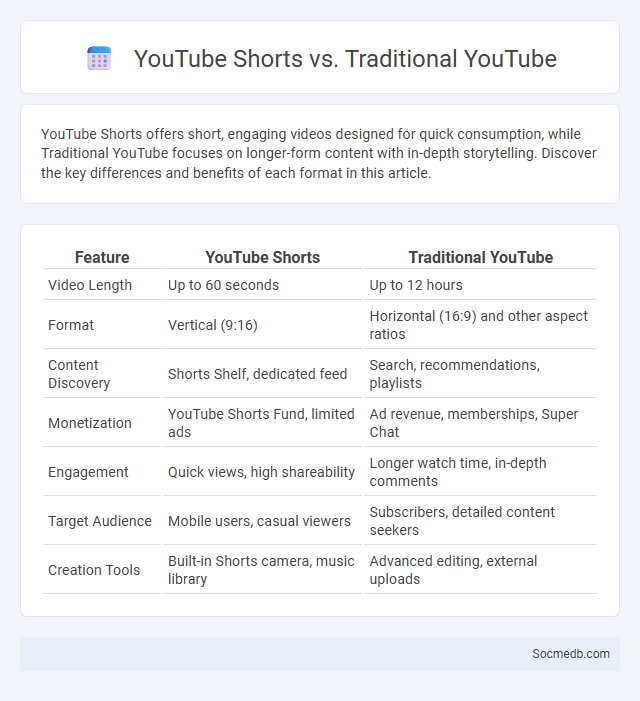
Photo illustration: YouTube Shorts vs Traditional YouTube
YouTube Shorts offers short, engaging videos designed for quick consumption, while Traditional YouTube focuses on longer-form content with in-depth storytelling. Discover the key differences and benefits of each format in this article.
Table of Comparison
| Feature | YouTube Shorts | Traditional YouTube |
|---|---|---|
| Video Length | Up to 60 seconds | Up to 12 hours |
| Format | Vertical (9:16) | Horizontal (16:9) and other aspect ratios |
| Content Discovery | Shorts Shelf, dedicated feed | Search, recommendations, playlists |
| Monetization | YouTube Shorts Fund, limited ads | Ad revenue, memberships, Super Chat |
| Engagement | Quick views, high shareability | Longer watch time, in-depth comments |
| Target Audience | Mobile users, casual viewers | Subscribers, detailed content seekers |
| Creation Tools | Built-in Shorts camera, music library | Advanced editing, external uploads |
Understanding YouTube Shorts: Definition and Features
YouTube Shorts are vertical videos up to 60 seconds designed for quick, engaging content on mobile devices. This format includes features like multi-segment camera recording, speed controls, and a vast music library to enhance creativity. Understanding these elements helps you create compelling Shorts that increase viewer engagement and channel growth.
What is Traditional YouTube? Core Differences
Traditional YouTube refers to the classic platform where creators upload long-form videos, typically over 10 minutes, focusing on in-depth content like tutorials, vlogs, and reviews. Core differences between Traditional YouTube and newer formats, such as YouTube Shorts, include video length limitations, viewer engagement strategies, and monetization methods. Traditional YouTube offers full-length video monetization with ads and memberships, while Shorts emphasize brief, snackable content prioritized by the algorithm for viral reach.
Content Length: Shorts vs Traditional Videos
Short-form videos, typically ranging from 15 to 60 seconds, dominate platforms like TikTok, Instagram Reels, and YouTube Shorts due to their quick consumption and high engagement rates. Traditional videos, often longer than five minutes, provide more in-depth storytelling, making them ideal for detailed tutorials, product reviews, and brand narratives. Metrics indicate short videos boost viewer retention rates by up to 80%, while longer formats foster deeper user connections and loyalty.
Audience Engagement: Short-Form vs Long-Form
Short-form social media content, such as TikTok videos and Instagram Reels, maximizes audience engagement by delivering quick, impactful messages that align with users' decreasing attention spans. Long-form content, like YouTube videos or LinkedIn articles, enables deeper storytelling and provides value that fosters sustained interaction and loyalty. Understanding your audience's preferences helps tailor content length to boost Your engagement rates effectively.
Algorithm and Discoverability: Shorts vs Traditional
Social media algorithms prioritize user engagement to enhance content discoverability, with Shorts leveraging rapid view counts and repeated watches to boost visibility. Traditional posts depend more on follower interactions and broader engagement metrics like comments and shares for sustained reach. You can maximize your online presence by tailoring content to these algorithmic preferences, ensuring Shorts gain traction through immediate impact while traditional posts build long-term audience relationships.
Monetization Opportunities: Which Format Wins?
Short-form videos dominate monetization opportunities on social media, with platforms like TikTok and Instagram Reels generating higher engagement and ad revenue compared to traditional image posts. Live streaming offers real-time interaction and tipping features that significantly boost income for creators. Your choice of format should align with your audience's preferences and platform trends to maximize earning potential.
Content Creation Strategies: Shorts vs Traditional
Content creation strategies differ significantly between shorts and traditional formats, impacting audience engagement and reach. Shorts, optimized for platforms like TikTok and Instagram Reels, leverage brief, dynamic visuals to capture attention quickly and maximize shareability, often resulting in higher organic growth and algorithm favorability. Traditional content, such as long-form videos or blog posts, allows for deeper storytelling and comprehensive information delivery, catering to audiences seeking detailed insights and fostering sustained viewer loyalty.
Channel Growth Impact: Shorts and Long Videos
Shorts and long videos each drive unique growth dynamics on social media platforms, significantly impacting channel expansion. Shorts boost rapid viewer engagement and channel visibility through bite-sized, easily consumable content, while long videos enhance watch time and subscriber retention by providing in-depth information and storytelling. Maximizing your channel growth requires a balanced content strategy leveraging both formats to attract diverse audiences and maintain sustained interaction.
Pros and Cons: YouTube Shorts Compared to Traditional
YouTube Shorts offers rapid content creation and increased viewer engagement through its short-form videos, making it ideal for viral marketing and quick information sharing. However, it may limit depth and content complexity compared to traditional long-form YouTube videos, which provide more detailed storytelling and comprehensive engagement. Monetization opportunities differ, with Shorts often facing lower ad revenue and creator payouts than traditional YouTube videos.
Choosing the Right Format: Shorts, Long-Form, or Both?
Selecting the right social media format depends on your audience engagement goals and content type. Shorts drive rapid views and high shareability, while long-form videos offer in-depth storytelling and stronger brand connection. You should analyze your platform analytics to determine whether shorts, long-form, or a strategic mix maximizes reach and retention.
 socmedb.com
socmedb.com